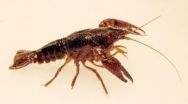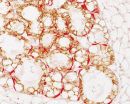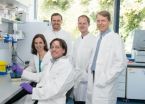(Press-News.org) To make a better optical fiber for transmitting laser beams, the first idea that comes to mind is probably not a nice long hydrogen bath.
And yet, scientists have known for years that hydrogen can alter the performance of optical fibers, which are often used to transmit or even generate laser light in optical devices. Researchers at the National Institute of Standards and Technology (NIST) have put this hydrogen "cure" to practical use, making optical fibers that transmit stable, high-power ultraviolet laser light for hundreds of hours. NIST scientists expect these hydrogen-treated fibers, described in Optics Express,* to reduce errors in logic operations in their quantum computing experiments.
Optical fibers generally are not able to transmit ultraviolet light because the short wavelength light can interact with dopants or impurities in the fibers, resulting in so-called "solarization" damage and extreme losses of beam intensity. The fibers effectively shut down. Hydrogen molecules have been shown to heal this damage as it occurs.
NIST researchers tested two types of fibers with solid cores made of fused silica surrounded by lattices of air holes, which form a crystal structure that maintains the shape of transmitted laser beams. The fibers were infused with hydrogen gas at 100 times standard atmospheric pressure for four to six days. Conveniently, some of the fibers could be treated in NIST's hydrogen pipeline materials testing facility.** After the hydrogen diffused into the fiber cores, the fibers were cured by exposure to ultraviolet laser light for several days.
NIST researchers then tested the fibers by transmitting ultraviolet laser light through them. The fibers did not display any solarization damage, even at output powers as high as 125 milliwatts (mW) at 313 nanometer (nm) laser wavelengths—several times the beam intensity needed for the group's quantum computing experiments. The combination of hydrogen infusion and curing with ultraviolet light "appears to confer long-term resistance" to this type of damage, according to the paper. The fibers also lose very little of the laser light as it is transmitted.
For comparison, NIST researchers also tested fibers that were not treated with hydrogen. With 313 nm wavelength laser light at 100 mW power, light transmission through the fibers dropped to zero in four hours, confirming the value of the hydrogen treatment.
The treated fibers could be used to transmit a wide range of infrared, visible and ultraviolet wavelengths of light, according to the research team. When used at NIST to transmit laser light to trap ions (electrically charged atoms), the fibers reduce stray light and fluctuations in laser beam pointing and make it possible to transfer ultraviolet light between separate optical tables, the paper notes. The fibers also can help "clean up" misshapen beams, the researchers say.
The same NIST research group has achieved many "firsts" using trapped ions to demonstrate building blocks for quantum computers, which would use the exotic properties of the quantum world to solve problems considered intractable today.
INFORMATION:
* Y. Colombe, D.H. Slichter, A.C. Wilson, D.G. Leibfried and D.J. Wineland. Single-mode optical fiber for high-power, low-loss UV transmission. Optics Express, Vol. 22, Issue 16, pp. 19783-19793. Published online Aug. 8, 2014. DOI:10.1364/OE.22.019783.
** See 2010 NIST Tech Beat article, "Future of Hydrogen Fuel Flows Through New NIST Test Facility," at http://www.nist.gov/public_affairs/tech-beat/tb20100216.cfm#hydrogen.
NIST therapy for ultraviolet laser beams: Hydrogen-treated fibers
2014-08-11
ELSE PRESS RELEASES FROM THIS DATE:
Stanford researchers uncover cancer-causing mechanism behind powerful human oncogene
2014-08-11
A protein present at high levels in more than half of all human cancers drives cell growth by blocking the expression of just a handful of genes involved in DNA packaging and cell death, according to a new study by researchers at the Stanford University School of Medicine.
The researchers found that the protein, called Myc, works through a tiny regulatory molecule called a microRNA to suppress the genes' expression. It marks the first time that a subset of Myc-controlled genes has been identified as critical players in the protein's cancer-causing function, and suggests ...
Blood cells are a new and unexpected source of neurons in crayfish
2014-08-11
Researchers have strived for years to determine how neurons are produced and integrated into the brain throughout adult life. In an intriguing twist, scientists reporting in the August 11 issue of the Cell Press journal Developmental Cell provide evidence that adult-born neurons are derived from a special type of circulating blood cell produced by the immune system. The findings—which were made in crayfish—suggest that the immune system may contribute to the development of the unknown role of certain brain diseases in the development of brain and other tissues.
In many ...
How breast cancer usurps the powers of mammary stem cells
2014-08-11
During pregnancy, certain hormones trigger specialized mammary stem cells to create milk-producing cells essential to lactation. Scientists at the University of California, San Diego School of Medicine and Moores Cancer Center have found that mammary stem cells associated with the pregnant mammary gland are related to stem cells found in breast cancer.
Writing in the August 11, 2014 issue of Developmental Cell, David A. Cheresh, PhD, Distinguished Professor of Pathology and vice-chair for research and development, Jay Desgrosellier, PhD, assistant professor of pathology ...
Malaria medicine chloroquine inhibits tumor growth and metastases
2014-08-11
A recent study by investigators at VIB and KU Leuven has demonstrated that chloroquine also normalizes the abnormal blood vessels in tumors. This blood vessel normalization results in an increased barrier function on the one hand -- thereby blocking cancer cell dissemination and metastasis -- and in enhanced tumor perfusion on the other hand, which increases the response of the tumor to chemotherapy.
The anti-cancer effect of the antimalarial agent chloroquine when combined with conventional chemotherapy has been well documented in experimental animal models. To date, ...
Climate change negatively impacting Great Lakes, GVSU researcher says
2014-08-11
MUSKEGON, Mich. -- Climate change is having a direct negative effect on the Great Lakes, including impacts to recreational value, drinking water potential, and becoming more suited to invasive species and infectious pathogens, according to a Grand Valley State University researcher.
The impact of climate change on the Great Lakes, as well as other natural resources in the United States, was explored in the report "Science, Education, and Outreach Roadmap for Natural Resources," recently released by the Association of Public and Land-grant Universities. Kevin Strychar, ...
CRI scientists pinpoint gene likely to promote childhood cancers
2014-08-11
DALLAS – Aug. 11, 2014 – Researchers at the Children’s Medical Center Research Institute at UT Southwestern (CRI) have identified a gene that contributes to the development of several childhood cancers, in a study conducted with mice designed to model the cancers. If the findings prove to be applicable to humans, the research could lead to new strategies for targeting certain childhood cancers at a molecular level. The study was published today in the journal Cancer Cell.
“We and others have found that Lin28b – a gene that is normally turned on in fetal but not adult ...
US immigration is associated with rise in smoking among Latinos and Asians
2014-08-11
Immigration to the U.S. may result in increased smoking in Latino and Asian women, according to new research from sociologists at Rice University, Duke University and the University of Southern California.
The study, "Gender, Acculturation and Smoking Behavior Among U.S. Asian and Latino Immigrants," examines smoking prevalence and frequency among Asian and Latino U.S. immigrants. The research focuses on how gender differences in smoking behavior are shaped by aspects of acculturation and the original decision to migrate. The study was published recently in the journal ...
Kessler Foundation researchers publish study on task constraint and task switching
2014-08-11
West Orange, NJ. August 11, 2014 -- Kessler Foundation scientists have published results of cognitive research that show the negative effects that unexpected task constraint, following self-generated task choice, has on task-switching performance. The article, "You can't always get what you want: The influence of unexpected task constraint on voluntary task switching", was published online on June 11 by The Quarterly Journal of Experimental Psychology (DOI:10.1080/17470218.2014.917115). The authors are Starla Weaver, PhD, and Glenn Wylie, DPhil, of Kessler Foundation, John ...
Study: 1 out of 5 adult orthopaedic trauma patients sought additional providers for narcotic prescriptions
2014-08-11
ROSEMONT, Ill.─"Doctor shopping," the growing practice of obtaining narcotic prescriptions from multiple providers, has led to measurable increases in drug use among postoperative trauma patients. The study, "Narcotic Use and Postoperative Doctor Shopping in the Orthopaedic Trauma Population," appearing in the August issue of the Journal of Bone & Joint Surgery (JBJS), links doctor shopping to higher narcotic use among orthopaedic patients. The data was presented earlier this year at the 2014 Annual Meeting of the American Academy of Orthopaedic Surgeons (AAOS).
"There ...
Keeping viruses at bay
2014-08-11
>
Our immunosensory system detects virus such as influenza via specific characteristics of viral ribonucleic acid. Previously, it was unclear how the immune system prevents viruses from simply donning molecular camouflage in order to escape detection. An international team of researchers from the University of Bonn Hospital and the London Research Institute have now discovered that our immunosensory system attacks viruses on a molecular level. In this way, a healthy organism can keep rotaviruses, a common cause of diarrheal epidemics, at bay. The results have been published ...






